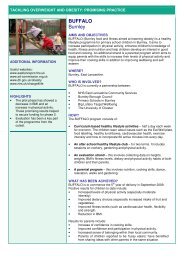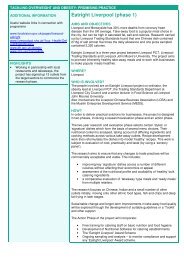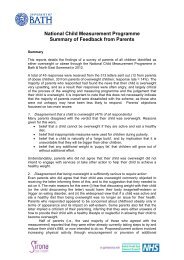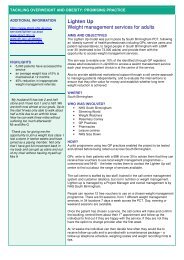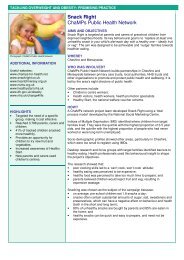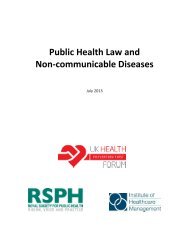The Challenge of Non-Communicable Diseases and Road Traffic ...
The Challenge of Non-Communicable Diseases and Road Traffic ...
The Challenge of Non-Communicable Diseases and Road Traffic ...
You also want an ePaper? Increase the reach of your titles
YUMPU automatically turns print PDFs into web optimized ePapers that Google loves.
58 <strong>The</strong> <strong>Challenge</strong> <strong>of</strong> <strong>Non</strong>-communicable <strong>Diseases</strong> <strong>and</strong> <strong>Road</strong> <strong>Traffic</strong> Injuries in Sub-Saharan Africa<br />
ier to introduce practices that benefit patients with<br />
chronic conditions [405].<br />
In many African countries primary care for NCDs<br />
is very poorly developed <strong>and</strong> expectations <strong>of</strong> what<br />
can be delivered need to take account <strong>of</strong> the realities<br />
<strong>and</strong> challenges faced. Practical policy proposals<br />
for improving primary <strong>and</strong> NCD care include:<br />
improving data on disease burden; implementing<br />
a structured approach to care delivery, with the<br />
part played by primary care in the broader system<br />
<strong>of</strong> care better defined; <strong>and</strong> highlighting quality <strong>of</strong><br />
care, aligned with broader health system strengthening<br />
[406]. A number <strong>of</strong> existing programs in<br />
low-resource countries such as TB control <strong>and</strong> maternal<br />
<strong>and</strong> child health include strengthening primary<br />
care as one aim. This creates an opportunity<br />
for improvements for NCD care to ‘piggy-back’<br />
onto existing efforts [406].<br />
Innovations to cope with staff shortages in primary<br />
care include developing a cadre <strong>of</strong> clinical associates<br />
to perform a limited clinical role, <strong>and</strong> on-site training<br />
<strong>of</strong> nurses <strong>and</strong> mid-level health workers for integrated<br />
care <strong>of</strong> chronic diseases, whether infectious<br />
or NCD in origin [399]. <strong>The</strong> role <strong>of</strong> appropriately-trained<br />
community health workers for NCD care<br />
should also be explored for SSA settings.<br />
Frameworks <strong>and</strong> simple, st<strong>and</strong>ardized protocols<br />
for case finding, diagnosis, <strong>and</strong> treatment <strong>of</strong> several<br />
risk factors <strong>and</strong> diseases can effectively be used by<br />
nurses <strong>and</strong> mid-level health workers [399]. <strong>The</strong>se<br />
may be adaptations <strong>of</strong> protocols for individual diseases,<br />
such as TB [407], <strong>and</strong> designed for the management<br />
<strong>of</strong> symptoms <strong>and</strong> signs <strong>of</strong> chronic disease,<br />
irrespective <strong>of</strong> cause (see Box 10) [408], potentially<br />
increasing cost-effectiveness by improving the care<br />
<strong>of</strong> several conditions [409].<br />
BOX 10: Integrated Care for <strong>Communicable</strong><br />
<strong>Diseases</strong> <strong>and</strong> NCDs in Primary Care<br />
In South Africa, cough is the commonest complaint in<br />
primary care <strong>and</strong> eight <strong>of</strong> the top 10 diagnoses are respiratory<br />
conditions <strong>of</strong> both an infectious <strong>and</strong> chronic<br />
nature, including upper respiratory tract infection, acute<br />
bronchitis, asthma, TB, <strong>and</strong> HIV-associated pneumonias<br />
[399].<br />
Programs such as PALSA PLUS (Practical Approach to<br />
Lung Health in South Africa) have been training health<br />
workers in state-funded primary care clinics to take a<br />
more people-centered rather than disease-centered approach,<br />
using a syndromic, integrated guideline for diagnosis<br />
<strong>and</strong> care <strong>of</strong> patients with respiratory symptoms<br />
[408]. An educational outreach program has enabled the<br />
guideline to be used successfully by nurse practitioners<br />
with favorable outcomes, including increased TB-detection<br />
rates, proportion <strong>of</strong> patients with asthma appropriately<br />
managed, <strong>and</strong> cost-effectiveness [409].<br />
<strong>The</strong> PALSA PLUS program has been extended to include<br />
the most frequently occurring NCDs in the primary care<br />
setting. This program is called ‘PRIMARY CARE 101’ [410].<br />
Widespread use <strong>of</strong> traditional medicine providers<br />
for primary care may reflect cultural <strong>and</strong>/or<br />
health beliefs, taboos, or inaccessibility <strong>of</strong> other<br />
forms <strong>of</strong> health care <strong>and</strong> drug costs, but one reason<br />
for its popularity may be a desire for continuity <strong>of</strong><br />
care [401]. <strong>The</strong>re have been moves to acknowledge<br />
its role within primary health care <strong>and</strong> national<br />
health systems, as well as to ensure its safety <strong>and</strong><br />
quality [411]. Better underst<strong>and</strong>ing <strong>of</strong> why people<br />
go to traditional healers could help inform the design<br />
<strong>of</strong> the health care delivery system for it to be<br />
more accessible <strong>and</strong> desirable to people, especially<br />
in rural areas.<br />
Chronic-Care Models<br />
Primary health care should not be seen in isolation<br />
– it is but one cog in a wheel <strong>of</strong> care that also<br />
involves secondary <strong>and</strong> tertiary care as well as the<br />
community <strong>and</strong> patient, in both public <strong>and</strong> private<br />
health systems. And while for SSA the challenge<br />
<strong>of</strong> strengthening primary health care remains, <strong>and</strong><br />
there is limited integration <strong>of</strong> NCD prevention <strong>and</strong><br />
promotion in primary health care, hospitals are also<br />
not ready in most countries to address even the existing<br />
burden <strong>of</strong> NCDs <strong>and</strong> RTIs.<br />
A further challenge is ensuring that various aspects<br />
<strong>of</strong> care are linked <strong>and</strong> coordinated across care levels<br />
<strong>and</strong> boundaries. Care <strong>of</strong> chronic conditions requires<br />
a complex response over an extended time period,<br />
involving coordinated inputs from a wide range <strong>of</strong><br />
health pr<strong>of</strong>essionals, continuous access to essential<br />
medicines, health information <strong>and</strong> monitoring systems,<br />
<strong>and</strong> a system that promotes patient empowerment<br />
[412]. Several organizational models exist





